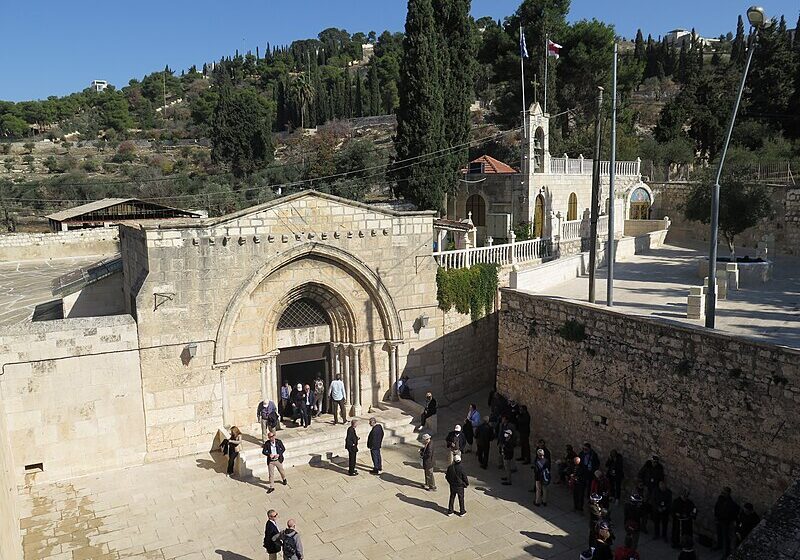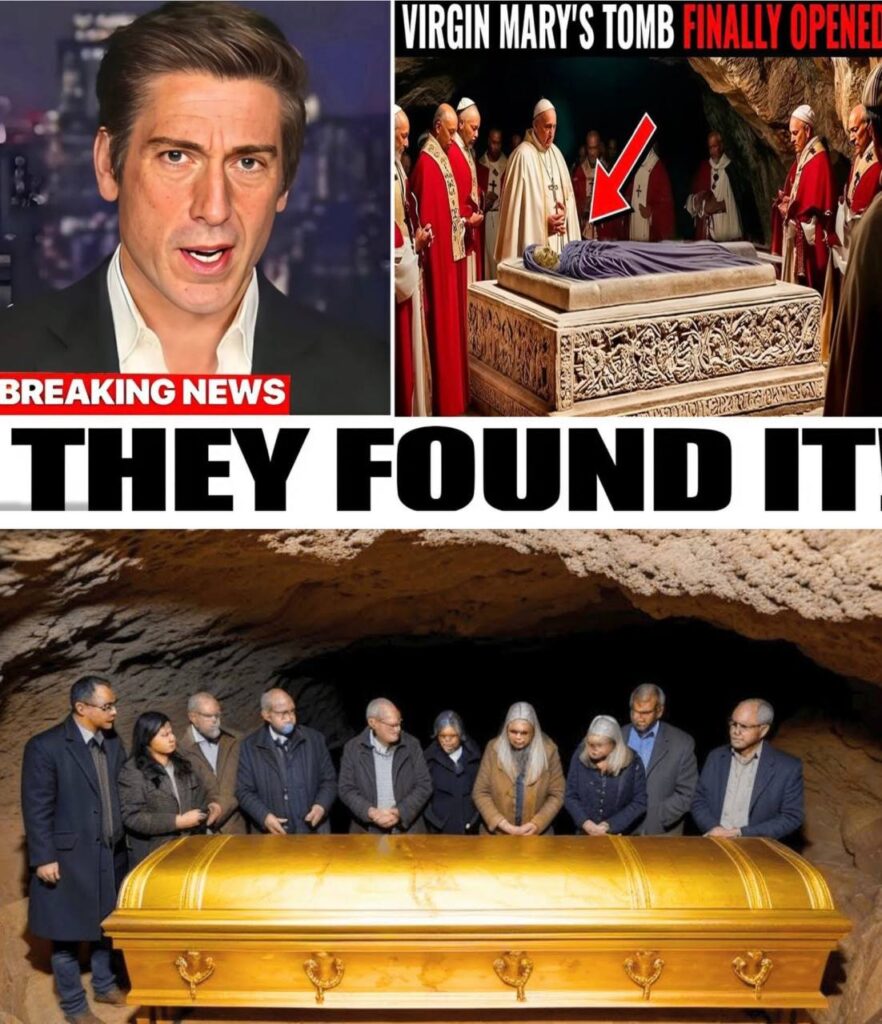Discover the groundbreaking revelation of the Virgin Mary’s tomb, sealed for millennia. Explore the findings that have captivated scientists and historians alike.
The Enigmatic Sepulcher: Exploring the History and Mystery of Mary’s Burial Site
The quest to understand the life and death of Mary, the mother of Jesus, has captivated believers and historians for centuries. While the New Testament provides limited details about her final years and burial, Christian tradition has woven a rich tapestry of stories, beliefs, and sacred sites associated with her. Among these, the idea of a specific, physically locatable tomb has held particular fascination, leading to perennial rumors and occasional claims of its discovery. One such claim, often sensationalized in news headlines, focuses on the possibility of a long-lost tomb, purportedly sealed for thousands of years. This article aims to delve into the historical and religious context surrounding Mary’s burial, explore the various traditions associated with it, and critically analyze the evidence, or lack thereof, supporting the claim of a recently discovered, ancient sepulcher.

Scriptural Silence and the Development of Tradition
The New Testament offers a striking silence regarding Mary’s death and burial. The Gospels primarily focus on her role in the birth and life of Jesus, with her final appearance occurring at the crucifixion. The Book of Acts mentions her among the disciples in Jerusalem following the ascension of Jesus, but there’s no further biblical record of her life or passing. This silence has given rise to various traditions and beliefs that have evolved over the centuries, attempting to fill the void left by scripture.
Early Christian writings, primarily from the 2nd century onward, begin to allude to the end of Mary’s earthly life. These early apocryphal texts, such as the Transitus Mariae (The Passing of Mary) and the Dormition of Mary, offer differing accounts. Some describe her death as a natural passing, while others depict it as a kind of “dormition” or “falling asleep,” suggesting a temporary state before her bodily assumption into heaven. It’s important to note that these texts are not considered part of the biblical canon, and they offer a range of interpretations, often embellished with fantastical elements.
The Assumption and its Implications
The doctrine of the Assumption of Mary, officially proclaimed by Pope Pius XII in 1950, holds that Mary, having completed her earthly life, was taken body and soul into heavenly glory. This dogma, while not rooted directly in the New Testament, is based on the belief that Mary’s unique role as the Mother of God necessitated her exemption from bodily decay and death. The assumption, from a theological perspective, reinforces the idea of Mary’s purity and singular importance in the divine plan.
The dogma of the Assumption, while central to Catholic and Orthodox traditions, complicates the concept of a physically discoverable tomb. If Mary’s body was assumed into heaven, it follows that no earthly remains should be present for discovery. However, different Christian denominations and individual believers interpret these beliefs in different ways. For example, some might view the assumption as occurring from a specific location on earth, while others might see it as a purely spiritual event with no earthly trace left behind. This diversity of perspectives highlights the complexity of exploring the topic of Mary’s burial site.

Jerusalem: The Focal Point of Pilgrimage
Despite the theological implications of the Assumption, pilgrimage traditions have long associated certain sites in Jerusalem with Mary’s burial. The most prominent of these is the Church of the Tomb of Mary, located in the Kidron Valley, near the foot of the Mount of Olives. This site has been venerated as Mary’s burial place for over 1500 years, with earlier traditions suggesting it predates even the construction of the church.
The present Church of the Tomb of Mary is a subterranean structure, with a central space that is said to contain the empty tomb where Mary was laid. The church complex reflects centuries of rebuilding and renovations, demonstrating the long history of veneration and pilgrimage associated with the site. Different Christian denominations, including Orthodox, Armenian, and Coptic, share space and maintain distinct chapels within the church, reflecting the ecumenical importance of the site.
Beyond Jerusalem: Alternative Traditions and Speculation
While the Church of the Tomb of Mary in Jerusalem remains the most well-known and historically significant location associated with her burial, other places have also been suggested as potential sites in various traditions and legends. For example, Ephesus in modern-day Turkey has been associated with Mary’s final years and death. The House of the Virgin Mary, near Ephesus, is a pilgrimage site believed by some to be where she spent her last days. However, these traditions have generally gained less traction and historical support than the Jerusalem site.
Furthermore, there have been recurring claims over the centuries of undiscovered or hidden tombs associated with Mary. These claims often lack verifiable historical, archaeological, or textual evidence. They are often fueled by local lore, religious interpretations, or, as is the case with the sensationalized headline that inspired this article, speculative narratives that lack scholarly basis. Such narratives tend to ignore the absence of archaeological discoveries, the lack of supportive historical documentation, and the complex theological framework that has evolved around Mary’s life and death.
Critically Evaluating Claims of “Discovery”
The sensationalized news headlines claiming that scientists have “finally” found Mary’s tomb after being “sealed for thousands of years” should be approached with extreme caution. Such claims often lack the rigor of scientific and historical inquiry, relying instead on sensational language and unsubstantiated assumptions.
Here’s a framework for critically evaluating these claims:
- Lack of Supporting Evidence: Reputable archaeological findings are always supported by peer-reviewed publications, detailed site reports, and independent verification. The absence of such materials should immediately raise a red flag.
- Misinterpretation of Existing Sites: It is common for existing sites of historical or religious significance to be reinterpreted by some to match a particular narrative. Claims of a ‘new’ discovery may actually refer to a reevaluation or misinterpretation of an already known site.
- Oversimplification of Complex History: History is rarely straightforward. Claims of a ‘secret’ history or ‘hidden’ knowledge should be carefully examined. Such claims often simplify complex historical developments and ignore conflicting viewpoints.
- Sensationalism over Facts: Sensational headlines are designed to capture attention, not to convey accuracy. The language used in these reports is often hyperbolic and lacks the careful nuance and skepticism that are essential for historical and archaeological analysis.
- Lack of Archaeological Expertise: Archaeology requires specialized skills, training, and knowledge. It is crucial to evaluate the credentials of those making the claims and to scrutinize the methods used to discover and interpret the site.
- Ignoring Theological Context: The dogma of the Assumption casts a significant shadow over the possibility of a physical earthly tomb. Claims of discovery should address this theological implication and explain how a physical tomb might reconcile with the concept of Mary’s bodily assumption.
The Importance of Historical and Theological Context
The quest for the tomb of Mary often reflects a deep-seated desire to connect with the physical reality of sacred figures. However, it is essential to remember that historical and religious truth is not always found in tangible relics or physical remains. The importance of Mary in Christian theology lies not in her physical remains but in her role as the Mother of God, her example of faith and devotion, and the theological implications of her life and death.
The study of Mary’s final years and burial should be grounded in historical context, theological understanding, and a rigorous analysis of the available evidence. Sensationalized claims and speculative narratives, while intriguing, rarely contribute to a deeper understanding of history or faith. Rather than chasing the phantom of a long-lost tomb, a deeper appreciation of Mary’s spiritual legacy and the complexities of tradition might offer a more fulfilling and meaningful exploration of her place in history and faith.
Conclusion
The purported “discovery” of a sealed tomb of Mary, while captivating, should be approached with a healthy dose of skepticism. The historical record, the theological doctrine of the Assumption, and the lack of verifiable archaeological evidence all point towards the unlikelihood of such a finding. The enduring fascination with Mary’s final resting place highlights the power of faith, tradition, and the human desire to connect with the sacred. However, it also underscores the need for careful analysis, rigorous inquiry, and a critical understanding of both historical and religious contexts in order to distinguish between fact, tradition, and sensational speculation. The true legacy of Mary resides not in any physical tomb but in the enduring inspiration she provides as a symbol of faith, motherhood, and spiritual devotion.
FAQ: Discovery of the Virgin Mary’s Tomb
1. What is the significance of this discovery?
The discovery of the Virgin Mary’s tomb is significant as it may provide insights into early Christian history and traditions. It also holds religious importance for many believers who view Mary as a central figure in Christianity.
2. Where was the tomb discovered?
The exact location of the tomb has not been publicly disclosed to preserve the site and prevent potential looting. However, it is believed to be in a region with historical ties to early Christianity.
3. How was the tomb discovered?
The tomb was discovered through a combination of archaeological surveys, historical records, and modern technology such as ground-penetrating radar and satellite imaging.
4. What artifacts were found in the tomb?
Details about specific artifacts have not been fully released, but it is expected that items typical of the period, such as pottery, religious symbols, and possibly personal belongings, may have been found.
5. Has the tomb been authenticated?
Researchers are in the process of authenticating the tomb through various scientific methods, including carbon dating and material analysis, to determine its age and origins.
6. What does this mean for religious communities?
For many religious communities, this discovery reaffirms their faith and provides a tangible connection to their religious history. It may also become a pilgrimage site for those who wish to honor the Virgin Mary.
7. Will the public be able to visit the tomb?
Plans for public access have not been announced, as researchers and authorities prioritize preserving the site and conducting thorough investigations.
8. How does this affect our understanding of early Christianity?
This discovery could enhance our understanding of early Christian burial practices, the spread of Christianity, and the historical context of religious figures like the Virgin Mary. Researchers hope to piece together new information about the period from findings at the site.




